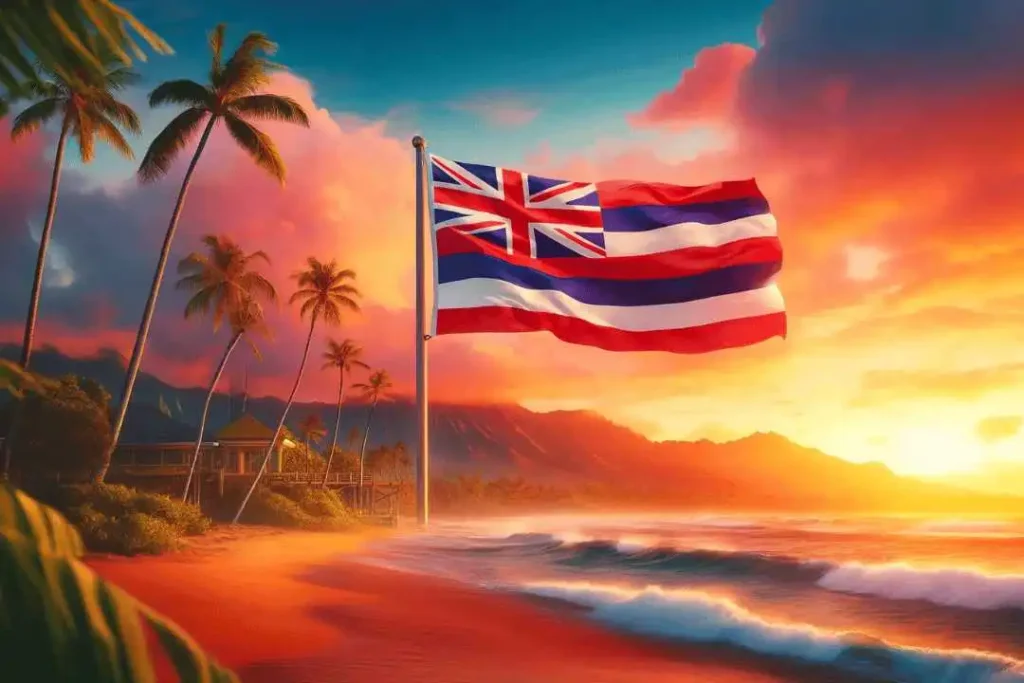The Hawaii flag, known as Ka Hae Hawaiʻi, is a symbol of the unique and rich history of the Hawaiian Islands. This vibrant emblem tells a story of cultural fusion, colonial influences, and a proud national identity. In this article, we delve deep into the fascinating aspects of the Hawaii flag, exploring its origins, design, significance, and the intriguing tales associated with it.
The Origins of the Hawaii Flag
The Hawaii flag has a history that dates back to the early 19th century. It was during the reign of King Kamehameha I that the first version of the flag was created. The need for a distinctive flag arose as Hawaii engaged in increasing trade with foreign nations. The flag’s design is often attributed to the influence of British naval officer Captain George Vancouver, who visited the islands in the 1790s. Vancouver’s suggestion was to adopt a flag that reflected Hawaii’s alliances and neutral stance in international relations.
A Blend of British and American Influences
One of the most striking features of the Hawaii flag is its design, which incorporates elements of both the British Union Jack and the American stripes. The Union Jack in the canton (top left corner) represents the historical ties with Britain, acknowledging the support and protection provided by British naval forces during King Kamehameha’s reign. The eight horizontal stripes of white, red, and blue symbolize the eight main islands of Hawaii.
This blending of British and American influences reflects Hawaii’s strategic position in the Pacific and its role as a meeting point for different cultures and nations. The flag’s design is a testament to Hawaii’s diplomatic efforts to maintain neutrality and foster peaceful relations with powerful nations during a time of global maritime expansion.
The Evolution of the Hawaii Flag

The Hawaii flag has undergone several changes since its inception. Initially, the flag featured only seven stripes, representing the islands of Hawaii, Maui, Oahu, Kauai, Molokai, Lanai, and Niihau. The eighth stripe, representing the island of Kahoolawe, was added later to reflect the inclusion of all major islands.
Another significant change occurred during the brief period when Hawaii was declared a republic in 1894. The flag was altered to remove the Union Jack, symbolizing a break from monarchical rule and the establishment of a new government. However, when Hawaii was annexed by the United States in 1898, the original design was restored, and the flag has remained unchanged since then.
The Symbolism of Colors and Design
Every element of the Hawaii flag carries deep symbolic meaning. The Union Jack represents Hawaii’s historical ties with Britain and its efforts to navigate the complex web of international relations. The stripes, with their vibrant colors, symbolize the eight main islands of Hawaii, emphasizing unity and the diversity of the Hawaiian archipelago.
The color red stands for courage and valor, reflecting the bravery of the Hawaiian people. White symbolizes purity and peace, while blue represents the ocean surrounding the islands and the sky above. Together, these colors create a powerful representation of Hawaii’s natural beauty, cultural heritage, and enduring spirit.
The Flag in Modern Times

Today, the Hawaii flag is a proud symbol of the state’s identity and heritage. It is flown at government buildings, schools, and homes across the islands, serving as a reminder of Hawaii’s unique history and cultural legacy. The flag is also a prominent feature in various state ceremonies and celebrations, such as King Kamehameha Day and Hawaiian Independence Day.
In addition to its official use, the Hawaii flag has become a popular motif in art, fashion, and popular culture. Its distinctive design and vibrant colors make it a favorite subject for artists and designers, who incorporate it into everything from clothing and accessories to home decor and tattoos.
The Hawaii Flag and Cultural Identity
The Hawaii flag is more than just a piece of cloth; it is a powerful symbol of cultural identity and pride. For many Native Hawaiians, the flag represents a connection to their ancestors and a reminder of their heritage and traditions. It serves as a symbol of resistance and resilience, particularly during times of political and social change.
In recent years, there has been a growing movement to reclaim and honor Native Hawaiian culture and history. The Hawaii flag plays a central role in this movement, serving as a rallying point for those advocating for the preservation and promotion of Hawaiian language, customs, and traditions.
The Legacy of the Hawaii Flag
The legacy of the Hawaii flag is one of adaptation, resilience, and pride. From its origins as a symbol of neutrality and diplomacy to its modern role as a representation of cultural identity and heritage, the flag has evolved alongside the history of the Hawaiian Islands. It stands as a testament to the strength and spirit of the Hawaiian people and their enduring connection to their land and culture.
Do Contact with us for any queries, services or business ideas.
Conclusion:
In conclusion, the Hawaii flag is a remarkable symbol with a rich history and deep significance. Its unique design, blending British and American elements, reflects Hawaii’s complex past and its role as a cultural crossroads in the Pacific. Today, the flag continues to inspire pride and unity among Hawaiians, serving as a reminder of their shared heritage and the beauty of their islands. Whether seen fluttering in the wind or displayed proudly in homes and public spaces, the Hawaii flag remains a powerful emblem of the Aloha spirit and the enduring legacy of the Hawaiian Islands.



